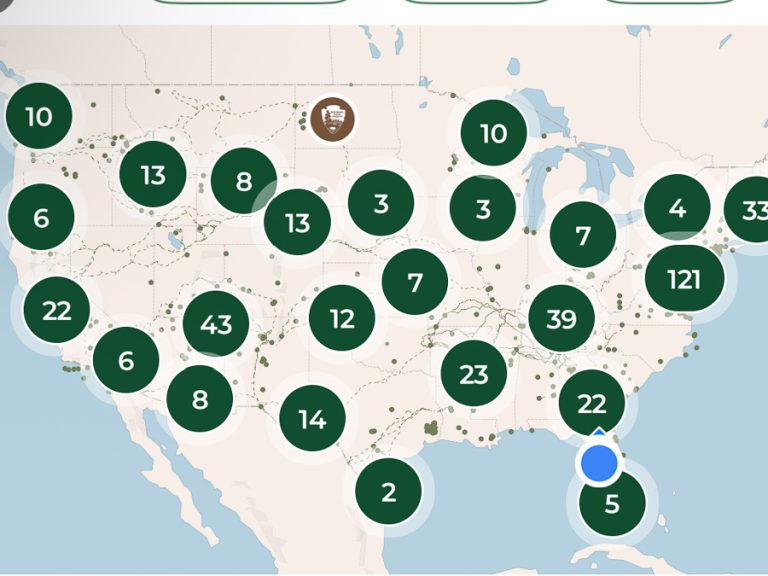Flying with Littles Is No Joke—But These 8 Airport Tips Can Help Keep the Chaos in Check
Before every trip with my young kids, I was frantically Googling things like, “Can I bring milk through security?” or “Do I have to fold my stroller at TSA?” I’ve been there—more times than I can count.
After 24 flights with babies and toddlers (and plenty of airport meltdowns), I’ve learned a few tricks. Today, I’m sharing my top 8 tips for surviving (and maybe even enjoying) the airport with young kids.
This post was written by my friend Jennifer, a fellow travel expert who runs Diapers to Destinations

1. Bring a Carrier or Stroller (Or Both!)
Let’s talk logistics.
Young kids are basically cats: sometimes they want to walk, sometimes they want to be carried, and sometimes they want to bolt in the opposite direction. You need a way to keep them close while juggling luggage, snacks, and your ever-dwindling sanity.
I always bring a carrier when I travel with little ones. My favorite for kids ages 0-2 is the Omni 360 Mesh Ergobaby Carrier. For kids 3-4 (my kids are small for their age!), I’ve used the Lillebaby toddler carrier for back carry.
Carriers keep your hands free for bags and boarding passes, and you don’t have to wake a sleeping child for TSA. That alone has saved my sanity more than once.
Not into babywearing? No worries.
A stroller is also a lifesaver – it doubles as a luggage cart and a kid wrangler.
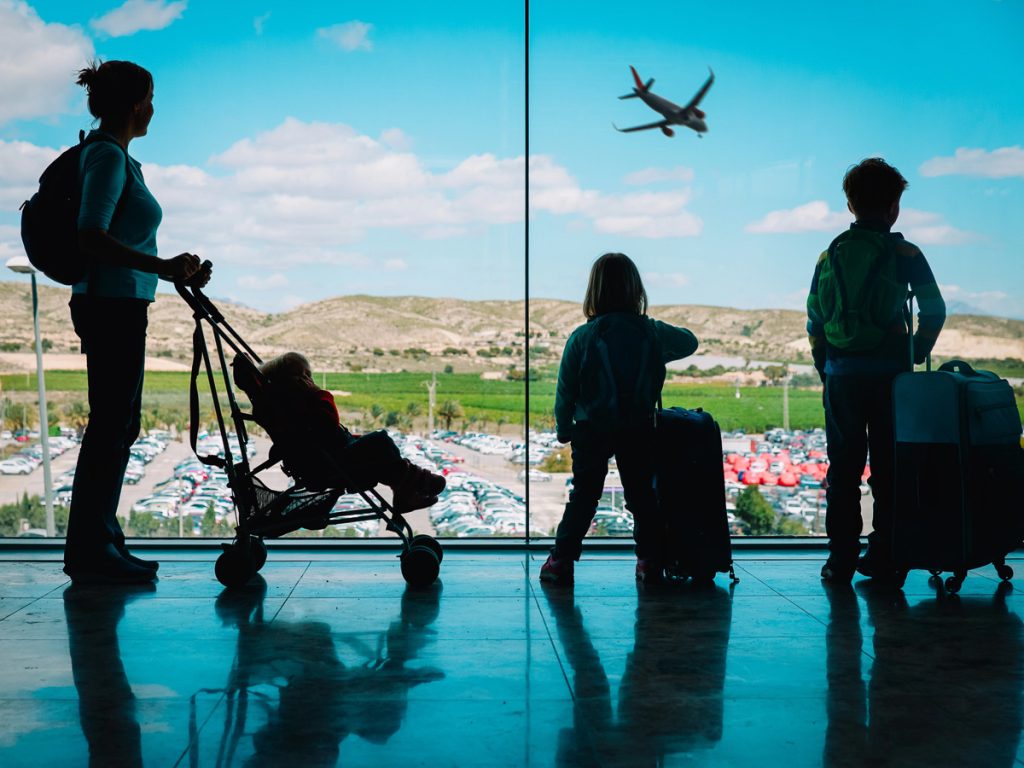
Just a heads up:
- You’ll need to take your kid out of the stroller when crossing security.
- If your stroller is small enough, you’ll have to fold it, so it can go through the x-ray machine. Otherwise, it will be manually inspected.
Pick what works for your family. Honestly, I’ve done both—sometimes on the same trip!
2. Know the TSA Rules for Parents Traveling with Kids
The security line is often the trickiest part of airport travel—but you can totally handle it if you know the rules.
TSA Liquid Rules for Babies and Toddlers
If you’re flying with a baby or a toddler, TSA actually allows some liquids over 3.4 oz (100 ml) because they’re considered “medically necessary.” This blew my mind the first time I learned it.
These exceptions include:
- Milk (including breast milk and whole milk, dairy or non-dairy)
- Formula (yes, even premixed, or water for mixing formula)
- Diaper rash cream
- Yogurt
- Applesauce
- Pureed foods
- Toddler drinks (juice, Pediasure, Horizon Growing Years, Pedialyte)
For more info on flying with food pouches and liquids: Flying with Baby Food Pouches? Here’s Your Simple TSA Guide
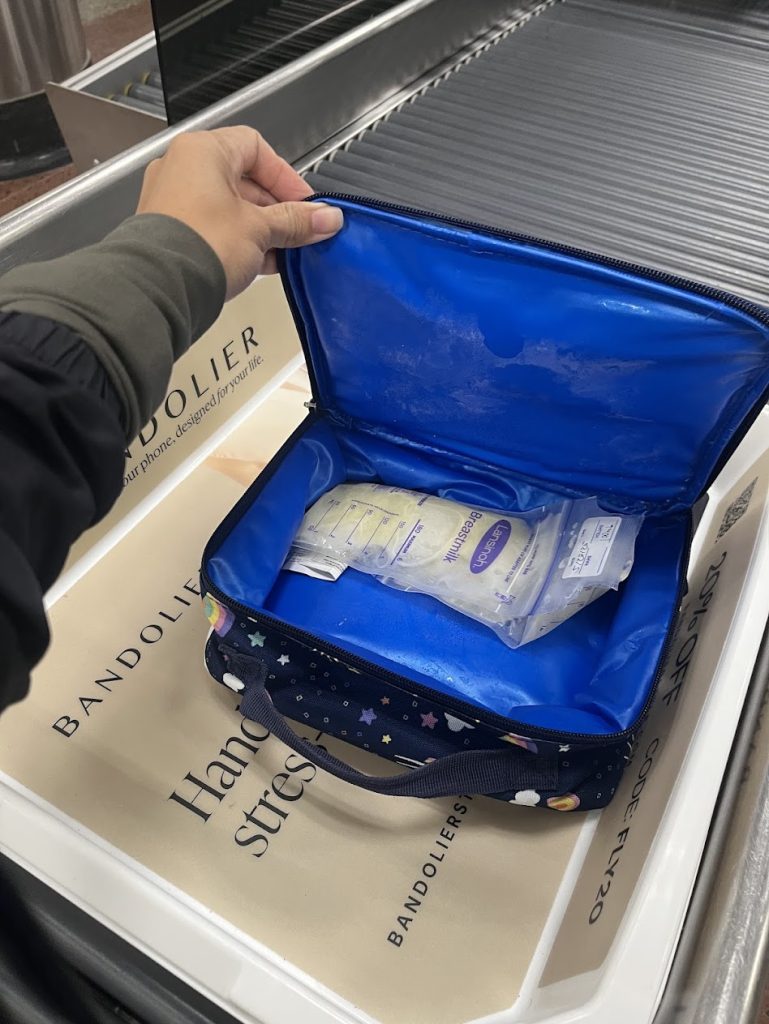
What to Expect in the Security Line
Here’s how it usually goes:
- Standard screening: Adults take off shoes, belts, and jackets, and put electronics in a separate bin. (If you have TSA PreCheck, you can keep these on and leave electronics in your bag.)
- Kids: Children under 12 can keep their shoes, headwear, and light jackets on. Small victories!
- Identification: For international flights, everyone (even babies) needs a passport. For domestic flights, adults need a REAL ID or passport. Kids might be asked for a birth certificate by the airline (I’ve only been asked once).
- Liquids: For faster screening, put any liquids—especially those over 3.4 oz (100 ml)—in a separate bin. Even though milk and puree pouches are allowed in larger amounts, they’ll need to be pulled out for extra screening, which usually just takes an extra minute or two. Trust me, it’s way easier to do this up front than to have TSA digging through your whole bag while you’re juggling your kid.
You’ll never be separated from your child during screening—huge relief. And if you’re babywearing, you usually don’t have to take your child out of the carrier. Score!
3. Handling Car Seats and Strollers at TSA
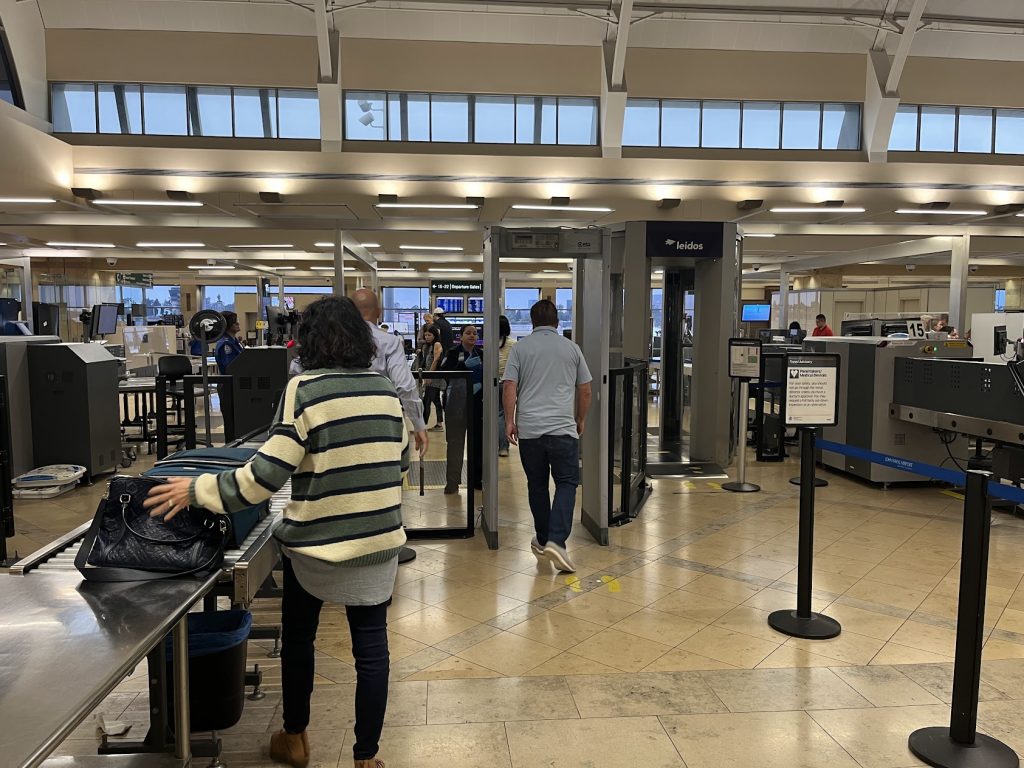
Only the items you bring all the way to the gate need to be screened. If you checked your car seat or stroller at the ticket counter, you’re off the hook at security.
You’ll need to take your child out of the stroller before it goes through screening.
- Car seats and smaller strollers: These usually go right through the x-ray machine. (It’s always a little funny to watch a giant car seat rolling down that tiny conveyor belt.)
- Larger strollers: If your stroller doesn’t fit in the x-ray, it’ll get a manual inspection. You’ll need to remove your child—cue the wiggling and protests.
Pro tip: Practice folding your stroller one-handed at home. You’ll feel like a total ninja at TSA when you can do it with a kid on your hip and a bag over your shoulder!
I’ve had TSA agents who were absolute gems, helping me wrangle everything while my toddler “helped” by pushing bins off the table. Just smile, accept the help, and remember: you’re almost through the hardest part!
For more info and tips: How to fly with baby and toddler car seats
4. Let Your Kids Move and Play After Security
Here’s the biggest mistake I see at the airport: keeping your toddler strapped in the stroller or glued to a tablet at a restaurant.
I get it—you just want five minutes to sip your overpriced coffee in peace. But your little one is about to be buckled into a tiny airplane seat for hours.
The airport isn’t just a waiting room. It’s your golden opportunity to let your kids get their wiggles out.
After we pass the security lines, I always let my kids run, climb, and explore as much as possible before we board. Honestly, even if I wanted my toddler to sit quietly, she wouldn’t. She’s a professional runner and climber.
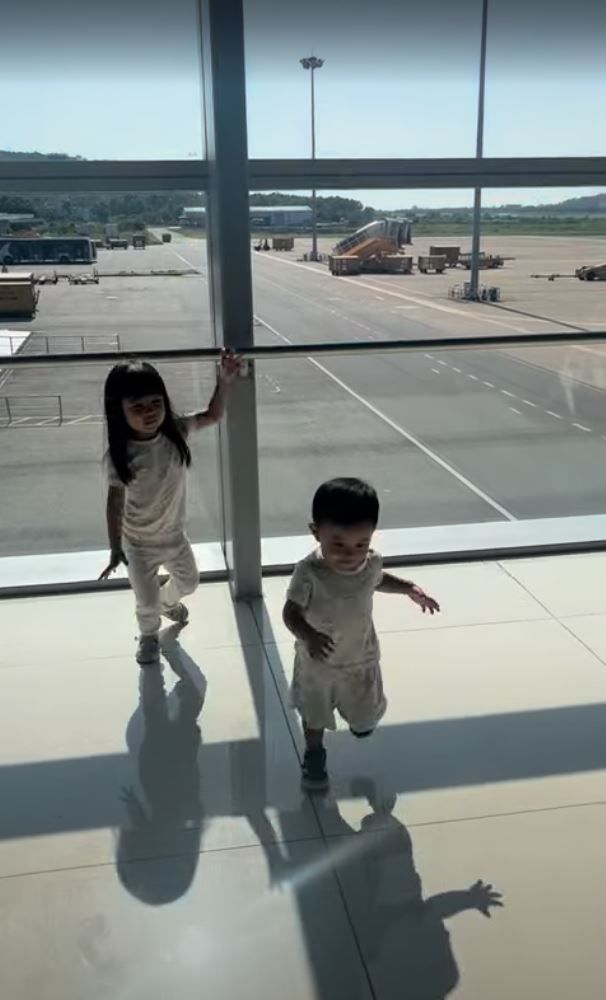
After some movement time at the airport, she’s usually calm (sometimes even sleepy) by the time we get on the plane.
Easy ways to let your kid move at the airport:
- Find an empty gate area. Let them run or play, as long as you’re not disturbing anyone.
- Try simple games. Simon Says, Red Light Green Light, or “I Spy” while walking past shops and gates.
- Take the stairs instead of the escalator. It’s free entertainment and a workout.
- Look for airport play areas. If your airport has an indoor playground, you’re totally winning.
Let them move now, so you have a better shot at them resting—or at least sitting semi-still on the flight—later.
5. Use Family Boarding to Your Advantage
Most US airlines let families with young kids board early (usually before your regular boarding group). This is a huge help!
Whenever we can board early, we do. It gives us a chance to put our carry-ons nearby, get the kids settled in their seats, and have extra time to carry bags or install car seats or CARES harnesses before the rest of the crowd gets on.
But every airline has different rules.
If your kids are older, you might have to board with everyone else.
Here’s what different airlines allow for family boarding:
- United Airlines, American Airlines, Alaska Airlines: Families with kids under 2 years old
- Frontier Airlines: Families with kids under 3 years old
- Delta Airlines, JetBlue: Families traveling with car seats and strollers
- Southwest Airlines: Families with kids under 6 years old
Always check your airline’s rules before your flight.
If you have a really active child, another strategy is to have one adult board early with the bags and gear, while the other stays back to let your child burn off energy until the very end.
For my family, we use family boarding because our kids like to stay together and feel safer that way. Do what works best for your family!
6. Take Advantage of Family-Friendly Airport Amenities
Airports can actually surprise you with how family-friendly they are—if you know where to look!
Family Rooms
Family rooms are clutch for keeping your whole crew (and your mountain of luggage) together. I always feel a little less frazzled when I can close a door and take a breath. It’s a great spot for regrouping, changing diapers, or just escaping the crowds for a minute.
Nursing Rooms
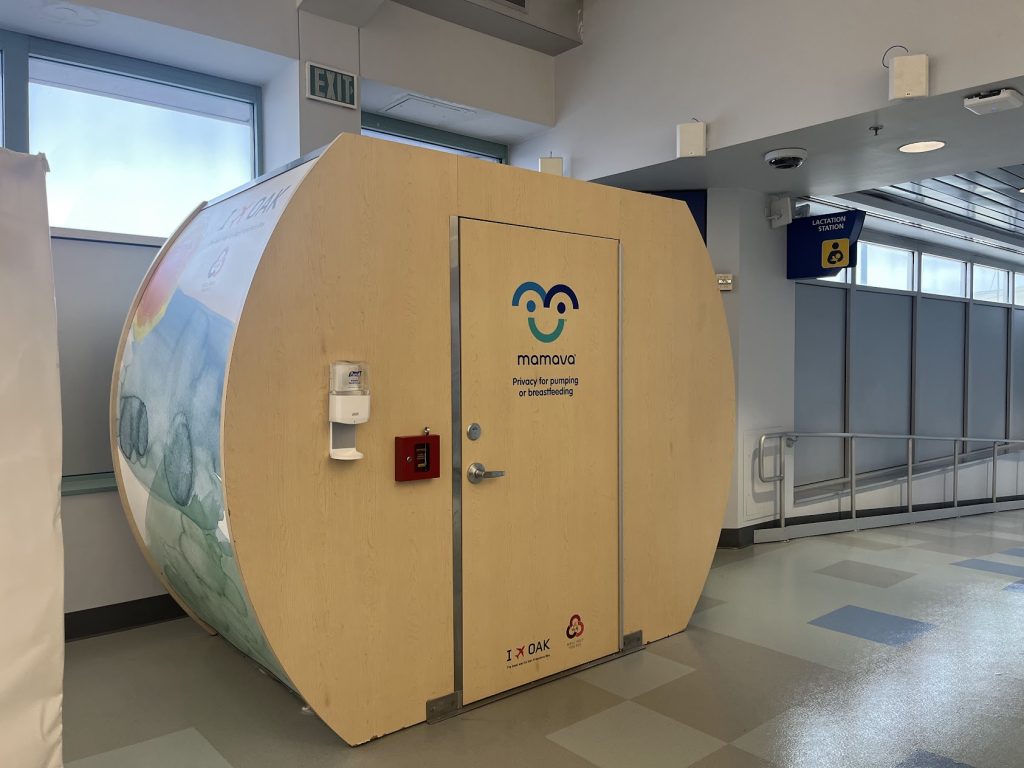
I’m a huge fan of nursing rooms. They’re clean, private, and perfect for feeding or changing a baby or young toddler who has demolished some snacks. I’ve even used them just to sit down and collect myself for a moment.
Lounges
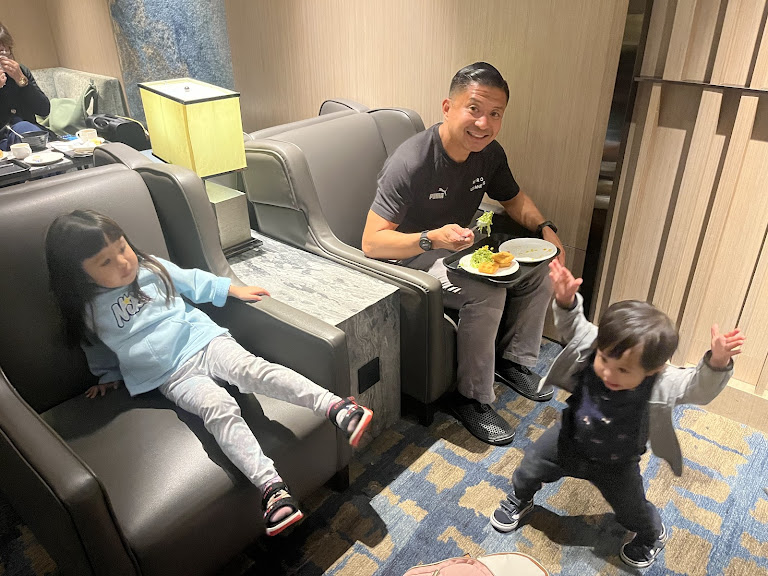
Airport lounges are quiet spaces away from the crowds, with comfy chairs, Wi-Fi, and (my favorite part) a small buffet of food and drinks. They’re basically a little oasis for parents and kids who need a break from the chaos.
I have the Chase Sapphire Reserve, so I get into Priority Pass lounges for free (well, for the annual fee I’m already paying). It’s honestly one of my favorite travel perks.
Nothing beats letting the kids pick out some snacks and having a spot to recharge devices. My kids think it’s a treat, and I think it’s a sanity-saving oasis.
Airport Playgrounds
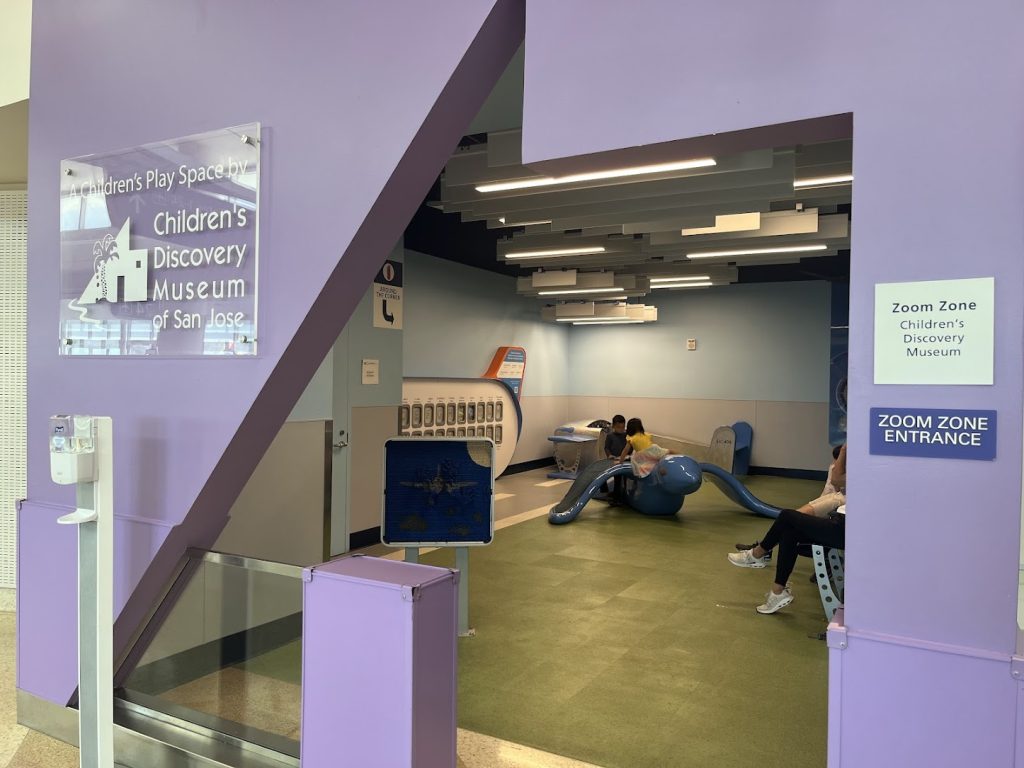
Many airports now have indoor play areas just for kids. These are perfect for letting your child burn off energy before a flight. If you have a layover or extra time, it’s worth checking if your airport has one.
You can find airport playgrounds at places like:
- San Jose (SJC)
- Los Angeles (LAX)
- Dallas-Fort Worth (DFW)
- Minneapolis-St. Paul (MSP)
Some are small play corners, while others are full playgrounds. Look up your airport ahead of time or ask at the information desk when you arrive. Your kids will thank you!
7. Pack Snacks and Toys for the Flight and Airport Downtime
Sometimes, flights get delayed and you end up spending hours at the airport. I’ve had delays of up to three hours—way more airport time than I planned… and with 2 kids in tow!
I usually save toys and snacks for the flight, but when we have to wait a long time, I bring them out at the airport too.
Snacks for Kids at the Airport
Airport restaurants and shops aren’t always open (early mornings and late nights). I’ve been stuck with two hungry kids and only my emergency snacks. Those snacks saved us from a total meltdown!
Pack snacks like:
- Crackers
- Bananas
- Tangerines
- Apple slices
- Shrimp chips (my kids love them)
- Puree pouches (nutritious and low mess)
Snacks can save the day when you’re stuck waiting.
Toys for Airports and Flights
Don’t bring too many toys. Two or three small, new things are enough.
Good toy ideas:
- Sticker books
- New coloring pad
- Water Wow coloring
- Fidget spinners
- Tiny toy car
Don’t give them all the toys at once. Give a new one when your child gets bored or fussy.
Snacks and a surprise toy can help you survive long waits and flights with kids!
Worst case, you can always buy a toy they pick out at the airport too (which I’ve done before).
8. Mentally Prepare for Airport Chaos (and Give Yourself Grace)
Let’s be honest: things will go sideways.
Flights get delayed. Kids spill snacks everywhere. Sometimes your carefully packed bag explodes at security.
It happens to all of us.
My advice? Let go of perfection. Celebrate the small wins, like making it through TSA without losing a shoe. Laugh at the chaos when you can.
Traveling with kids is a badge of honor. You’re showing them the world, and that matters.
I used to be terrified of the judgey stares when boarding with a baby or toddler. But here’s the truth: people can choose a child-free life, but not a child-free world.
Commercial airlines are public transportation—just like the bus or train. You and your child have every right to be there.
If someone wants absolute silence, they can charter a private jet!
Your job isn’t to keep your kids silent and motionless. You’re a paying customer.
Give yourself grace. You’re doing something amazing.
Final Thoughts
If you’re still here, you’re already ahead of the game.
No one travels perfectly with kids. But you’re showing your little ones the world, and that matters.
Parenting is hard anywhere. Toddlers are wild no matter where you are. You might as well do it somewhere magical.
For more real-world tips with toddlers, check out my guide: Flying With A Toddler (1-3 years old) From a US Airport: Everything You Need To Know
If the thought of travel is tugging at you, take it as a sign. Make the memories. Take the trip.
